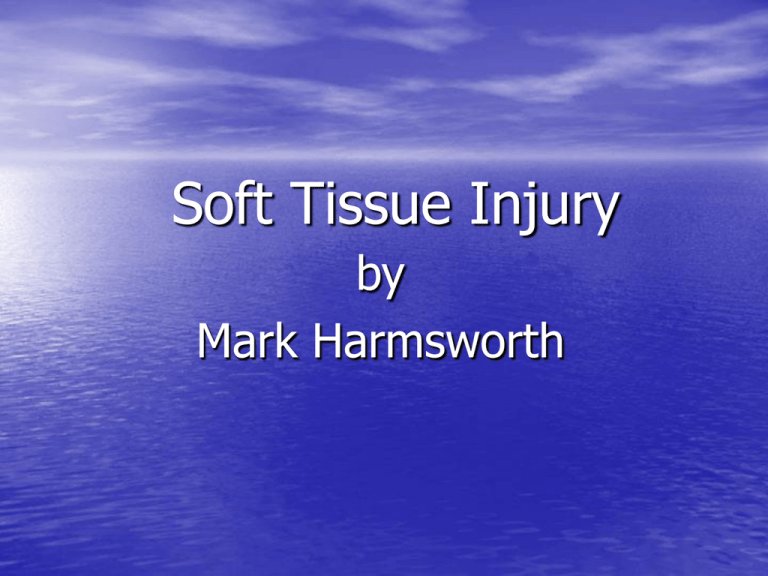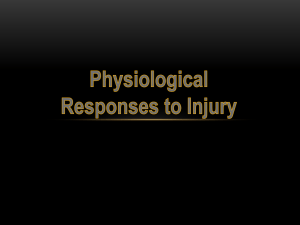Microsoft PowerPoint
advertisement

Soft Tissue Injury by Mark Harmsworth What is Soft Tissue? • Skin • Ligaments – connects bones at joints • Tendons – attaches muscle to bone • Fascia – dense connective tissue • Skeletal Muscle – usually attached to bone and moves parts of the skeleton • So, tissue that has not hardened into bone and cartilage What are the Type of Injuries? • Sprain ligaments are • • commonly caused by indirect impact, overstretching (twisting) Muscle strains – pulling action, over stretching, rupture or direct trauma / overuse. Includes tendons Contusions (bruise) – direct blow • Intramuscular hematoma • is confined to the muscle compartment which fills up with blood. Is more painful and restrictive of ROM Intermuscular hematoma is when the blood escapes through the fascia and so becomes distributed, thus bruising will be evident Skeletal Muscle Sliding- Filament Theory • Muscle cell ‘fibre’ includes • • myofibrils which consist of 2 types of protein called thick and thin filaments Thick filaments are formed with myosin protein, while thin filaments with actin protein. Both form the main contractile elements of muscle and as a unit is called a sacromere The length of sacromere is determined by the sliding nature of the thick and thin filaments which overlap Muscle • Arranged to correlate with the power needed • Grouped in orientation of their fibres – parallel / oblique or pinnate / spiral • The agonist or prime mover (muscle) brings about movement • At the same time the antagonist relaxes Soft Tissue Healing from Injury • Repairing damaged tissue • Replaced by granulation tissue, which matures to form scar type tissue • Phases overlap • Bleeding / inflammatory / proliferation / remodelling phases Bleeding Phase • Bleeding time to stop will vary with the nature of both the injury and tissue • Short lived 6 – 8 hours (acute stage) • Reduces up to 24hrs • Muscles will bleed longer than other structures i.e. ligaments Inflammatory Phase • • • • • • • Essential component of tissue repair Rapid onset - first few hours Quickly increases to maximum 2 – 3 days Gradually resolves over next few weeks Largely beneficial Is accompanied by debris removal and repair of damaged tissue Over response can cause problems Proliferation Phase • Generation of the repair material • Production of scar tissue (collagen material), needs to be laid down in an orientated way • Rapid onset 24 – 48 hours • Peaks 2 – 3 weeks / bulk scar tissue • Final products several months • Repair tissue is different. Fibres shorter, inelastic and different elasticity, increases risk of recurrence of rupture Remodelling Phase • Greatly overlooked phase • Results in organised / functional scar tissue • Starts as early as 2 weeks • Continues for months to a year • With maturity, the collagen becomes more orientated in line with local stress Proliferation / Remodelling Phase – Important in Successful Healing • Collagen fibres need to be orientated to provide • • • tensile strength in the right direction Using normal stresses via movement, collagen can be laid down this way If not, collagen fibres are laid in haphazard and thus weakened pattern is caused With maturity, the collagen becomes even more orientated in line with stress What Does This Mean for Treatment ? • Excessive bleeding should be discouraged • Inflammation is normal and essential, though • • • when acute and continues, can cause problems. A question re- NSAID’S use (See next slide) Early gradual mobilisation (active rest) orientates scar tissue in the line of stress, similar to normal tissue plus early movement helps breaks down adhesions Unhelpful adhesions / scar tissue will need direct intervention – Sports massage techniques Remodelling is helped by gradual return to full physical stress - rehabilitation programme NSAID’s as pain relief for STI • As inflammation process is important can • • • NSAIS’s delay overall recovery? Inhibit COX enzymes and production of inflammatory prostaglandins (these introduce inflammatory cells to the area) Thus reduces pain, swelling , oedema which can cause anoxia / cell damage Inhibit COX can alter thromboxane and platelets and so increase bleeding / swelling at site. NSAID’s as pain relief for STI • Tendon injuries in those over 40 are usually due • • • to tendonosis in nature rather than inflammation Research are inconclusive and involves use in animals rather than human trials Guidance – use NSAID’s for treating chronic inflammation and acute like bursitis and confirmed tendonitis Use paracetamol for pain relief (though use of single NSAID doses won’t have any effect) Overuse Syndrome / Sports • Muscular system develops to the way it is used • Individuals have unique pattern of imbalances • Bundles of muscle fibres react fractionally in a different way, causing small areas to be under slightly greater pressure than surrounding areas • A few fibres are damaged at microscopic level • Causes secondary muscle tension to the surrounding tissue OVERUSE SYNDROME BEGINS Overuse Syndrome • Same as normal tissue response of bleeding / • • • • inflammation and formation of scar tissue, yet at a microscopic level Secondary muscle micro-tension may cause soreness but no real pain and activity continues as inflammatory response is small Moderate activity is helpful at this stage yet further continuous stress prevents recovery Adjacent fibres work harder due to micro tissue damage, which is less contractual and stretchy More micro trauma / scar tissue occurs so less elasticity and the circle continues Overuse Syndrome You are full into overuse syndrome • As small parts of muscle deteriorate, imbalance • • • in the muscle and the group occurs 1 muscle problem then effects different muscle systems. May still be unnoticed ! Tendon tension increases and may tear (acute) Biomechanical faults develop, causing more problems elsewhere in the musculoskeletal system How to Treat / Stop Overuse Syndrome • Effective and efficient training, includes correct • • • biomechanics. Be prepared to adapt Have rest days (please), vary training Use soft tissue massage (STM) techniques to identify and treat problems before any symptoms are recognised STM to intervene in soft tissue problem i.e. adhesions / scar tissue FIND THE CAUSE Soft Tissue Injury Approach • Facilitate / promote normal tissue repair • Immobilization and early mobilization • Enhance sequence of events • Promote normality • Appropriate therapy to influence the process in a positive way • Intervene if needed i.e. adhesions / infection / overuse syndrome References Scar / collagen orientation in Soft tissue issues the lines of stress • Anderson, C., et al 2004* • Forrest, L., 1983 • Fox, S and Pritchard, D., • Hardy, M., 1989 2004 • Norris, C., 2004* • Watson, T., 2006 * • Watson, T., 2006* Overuse syndrome • Cash, M., 1996* • Paine, T., 2007 • Sanderson, M., 2002 • • • • Sliding – filament theory • www.ivyrose.co.uk (Accessed April 2008) • NSAID’S / INFLAMMATION Becker, D., 2010 Braund, R., 2006* Khan, K. et al 2000. McGriff-Lee, M., 2003 Stovitz, S and Johnson R., 2003* Watson, T., 2006





